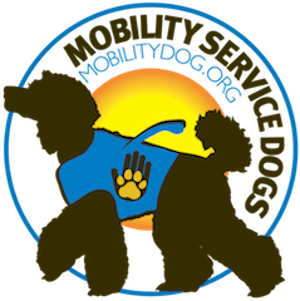Puppy Socialization - Why it Matters
Socialization is a MOST IMPORTANT for all Service Dogs-in-Training!
Puppy Socialization – Why It Matters
For most of us, our pooches are pets and treasured companions. A well-adjusted animal is crucial to a positive, life-long relationship between humans and canines. Proper socialization, which begins in puppyhood and extends for the life of the dog, forms the foundation for a mutually satisfying dog-person bond.
Basic Socialization Requirements
While dogs still perform specific jobs in many contexts – guarding, rescuing, guiding, serving – the most common job description for the canine population is “companion” – sidekick, playmate, friend. We take advantage of our dogs’ unique ability to communicate effectively with us – to understand what we require of them, and to let us know what they need from us. Some of this competence is genetically based. Dogs evolved, along with humans, to form the human-canine link. Some also derives from training. Dogs that have been raised to be calm, tractable and connective enjoy more success as family members than do animals that have not had the benefit of early training. This is where socialization comes in.
3 Phases of Socialization
The overall goal of socialization is desensitization, i.e., equipping a dog to cope with many different stimuli, reacting calmly to the variety of experiences, objects and animals (including humans) she will encounter over her lifetime.
Socialization, and the social development it confers, occurs in three phases:
The primary period
The social development period
The enrichment period.
The primary period is short – it lasts from birth through the first three weeks of life. During this time, a puppy’s sensory capabilities are limited, so they rely entirely on their mother’s care. Nevertheless, important development is taking place. Tactile experiences in these first few weeks help young dogs develop a tolerance for physical contact. When puppies are handled gently, they experience (and learn to tolerate) mild stress levels. As with humans, coping with low-level stress builds resilience a dog draws on later when confronted with stronger stimuli.
The socialization period occurs between approximately three weeks and 12 weeks of age. Dogs play with their littermates, running in groups and tumbling about in puppy piles. Fear responses tend to develop during this period. Observers report that, at around five weeks, dogs show aversion to loud noises and unfamiliar environments. Over time, they learn which stimuli represent danger and which are harmless.
Demonstrated resilience to the world’s complexities evolves significantly during the socialization period, but the process does not end here. The third developmental period, enrichment, is important for continued exposure to the experiences a dog will encounter over the rest of its life. By this time, a dog will have had sufficient vaccinations to venture into the broader world without incurring a significant risk of communicable diseases. During the enrichment phase, a pup should experience the full range of contacts and perceptions the world offers, the panoply of novel people, animals, places, sounds and objects. Building on the resilience developed in the second phase, this third stage continues a socialization process that should continue through a dog’s juvenile period and into adulthood.
Benefits of Socialization
Lack of early socialization can lead to such problematic behaviors as undesirable aggression and fearfulness. Dogs that haven’t been exposed as puppies to contact with other dogs, adults and children may be unable to form the strong social bonds required to function well as a family pet.
Even dogs that are expected to do work beyond providing individual companionship benefit from socialization, and may suffer from diminished performance if not socialized fully and properly. One study showed that playing search games with humans as puppies provides an important developmental opportunity for dogs that are candidates for search and rescue work. Dogs that had not been exposed to people before they were a year old could never learn to play a searching game; dogs with human exposure, in contrast, were able to learn the game and thus had a leg up in mastering more complex search and rescue skills.*
How Much Socialization Is Enough?
Is there a point beyond which a dog’s social adeptness does not improve with more exposure to the big, complex, highly stimulating world? Current research does not provide a clear answer. On the one hand, there may be a tipping point of adequate socialization, beyond which the law of diminishing returns kicks in and further improvement can’t be observed. On the other hand, most dog behavior experts counsel owners to continue providing socially enriching experiences throughout the dog’s livef. Dog training is, after all, a lifelong learning process for both canines and humans. Why not continue to ensure your pooch enjoys the enriching diversity of experience that helped mold her into the companion she has become? You’ll both benefit.
*Tiffani J Howell, Tammie King & Pauleen C Bennett (2015) “Puppy parties and beyond: the role of early age socialization practices on adult dog behavior,” Veterinary Medicine: Research and Reports, 143-153, https://doi.org/10.2147/VMRR.S62081. See page 145 for the study referenced.
UPCOMING: MobilityDog’s A.R.F.! Accessibility Resource Fair @ Pasadena City Hall the FIRST SATURDAY of MAY!



